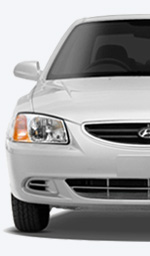 printable version printable version
Instructions
Recommended fuel
Unleaded petrol
At Hyundai cars must use unleaded gasoline with an octane rating of 91 RON (research method, "Normal") or higher. Leaded petrol will lead to failure of the catalytic converter (exhaust gas) and damage to the systems of decrease in toxicity. This may also lead to increased maintenance costs of the vehicle. In order to avoid the possibility of refueling the vehicle with leaded fuel filler neck of the car is designed so that it can be inserted only fuel nozzle of reduced diameter, is used to supply unleaded fuel.
A warning  In some countries supplied cars Hyundai having the opportunity to work on leaded fuel. If you are going to use leaded fuel, consult your authorized dealer Hyundai of the possibility of the use of leaded fuel in your car. The octane number of leaded gasoline is same as unleaded. In some countries supplied cars Hyundai having the opportunity to work on leaded fuel. If you are going to use leaded fuel, consult your authorized dealer Hyundai of the possibility of the use of leaded fuel in your car. The octane number of leaded gasoline is same as unleaded.
 The warranty on a new car Hyundai does not cover damage to the fuel system and reducing engine performance caused by the use of methanol or fuel containing methanol. The warranty on a new car Hyundai does not cover damage to the fuel system and reducing engine performance caused by the use of methanol or fuel containing methanol.
Environmentally friendly fuels
In order to lower air pollution, the firm Hyundai recommends the use of fuel having a cleaning additives to help prevent carbon formation in the engine. This fuel will contribute to a more environmentally friendly engine and the best characteristics of systems of decrease in toxicity. RUNNING CAR During the first 2,000 kilometers
Formally, for your new car does not require any special operations for the running of the car. However, you can prolong the life and improve fuel efficiency and maintain high performance of your new Hyundai vehicle, observing the following rules for the first 2,000 km.
| PERFORMANCE ORDER | | Do not exceed the velocity of 88 km / h. | | While driving, keep the engine at a speed between 2000 and 4000 min-1 (rpm). | | Do not drive the vehicle with the maximum acceleration. | | Avoid pulling away at full power. | | Avoid sudden braking during the first 300 kilometers, eliminating dangerous situations. This will help correct running-in brake linings. | Do not overload the engine (in other words, avoid driving at slower included too high a transfer, including a lower gear).
On vehicles equipped with catalytic converter, do not run the engine at idle for more than 3 minutes. | | Refrain from towing a trailer during the first 2,000 km. |
|
|







